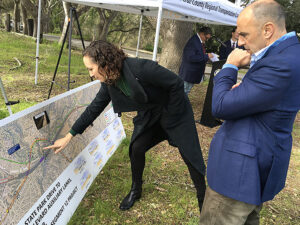By Jondi Gumz
Surely everyone driving Highway 1 from Aptos to Santa Cruz has noticed many of the trees on the shoulder are now no more than stumps.
It’s a sign that the Highway 1 auxiliary lane project between Soquel Avenue and 41st Avenue will soon commence.
This project includes bike and pedestrian overcrossings for safety and shoulders for Metro buses to bypass traffic jams during peak congestion — which seems to be every weekday afternoon.
To address this situation, the RTC created the “Watsonville-Santa Cruz Multimodal Corridor Program,” which qualified for a new competitive federal grant for projects with no other funding solution that could help meet national or regional economic, mobility, or safety goals.
The Watsonville-Santa Cruz program is one of nine in the nation to be chosen for this round of funding from the Infrastructure Investment and Jobs Act.
Local voters in 2016 approved a half-cent sales tax dedicated to transportation improvements, but with so many projects to do — Highway 1 auxiliary lanes, Highway 9 corridor, Highway 17 wildlife crossing, Rail Trail — more money was needed.

Sarah Christensen, Santa Cruz County Regional Transportation Commission engineer, points out the location of the “Aptos Strangler” traffic jam to U.S. Rep. Jimmy Panetta, D-Carmel Valley. • Photo Credit: Jondi Gumz
U.S. Rep. Jimmy Panetta (D-Carmel Valley) saw the need and was able to secure $30 million from this new federal funding for the Highway 1 project.
“For far too long and far too often, too many people have been stuck in traffic on Highway 1 getting between Watsonville and Santa Cruz, leading to a decrease in our productivity and an increase in our carbon output,” Panetta said.
“I’m proud that Congress passed the bipartisan Infrastructure Investment and Jobs Act in order to make this type of crucial federal investment in our roads and green buses that will help alleviate traffic, improve our livelihoods, and allow us to play our part to stem the effects of climate change,” he added.
And that’s not all.
Local officials say there’s enough money to purchase four zero-emission buses for Santa Cruz Metro and build a segment of the Coastal Rail Trail from State Park Drive to Rio Del Mar Boulevard in Aptos.
On Feb. 21, county supervisors Manu Koenig and Felipe Hernandez joined Panetta for a press conference to highlight what the money could do.
Hernandez, who represents Watsonville and previously served on the City Council, recalled how women living in Watsonville and working at a manufacturing plant in Santa Cruz were spending hours commuting to and from work on Highway 1 and wanted to change their start time from 8 a.m. to 10 a.m. to address the problem.
He noted the county is renovating the former West Marine headquarters in Watsonville to locate more county services closer to South County residents so they can avoid Highway 1, hopefully by the end of the year, and then looking to expand health services at the Freedom Boulevard campus in Watsonville the following year. Both moves are expected to bring some Highway 1 relief.
Sarah Christensen, senior transportation engineer with the Santa Cruz County Regional Transportation Commission, pointed out how Soquel Drive, Highway 1 and the rail corridor come together to create the “Aptos Strangler,” the traffic logjam so many wish could be untangled.
“We’re going to fix it,” she said.
Transportation expert Jarrett Walker coined the term “Aptos Strangler” during a local presentation in 2016.
The federal government’s generosity came as a surprise to Koenig.
“I didn’t know this was a possibility,” he said. “All of a sudden, we’re golden.”
Koenig’s supervisorial district includes 5940 Soquel Ave., on the Highway 1 frontage road, where a 160,000-square-foot medical office building plus parking garage is proposed for Kaiser Permanente, which expects to bring 300 employees to the site.
Neighbors are worried Soquel Ave., a two-lane road lacking sidewalks and bike lanes, and their neighborhood streets will be overwhelmed by traffic.
The developer, PMB, must submit the final environmental impact report and host a community meeting. That didn’t happen in December, January or February.
After the community meeting, the project goes to the county Planning Commission and then the county Board of Supervisors.
Koenig pointed out the $25 million in improvements known as the Soquel Drive buffered bike lanes are being rebid, with bids due March 16. See story on page 22.
He also said Jarrett Walker, who reimagined the Houston Metro bus system to connect people to jobs with no substantial increase in operating cost, has been hired to re-evaluate Santa Cruz Metro routes.
One more benefit from the $30 million: CalTrans estimates the Highway 1 project will create 2,167 jobs and improve access to top employers in Santa Cruz County.
In the meantime, county officials will turn their focus to housing — to map out places where homes can be built to satisfy the state’s demand for Santa Cruz County to build 4,634 housing units in the next eight years.